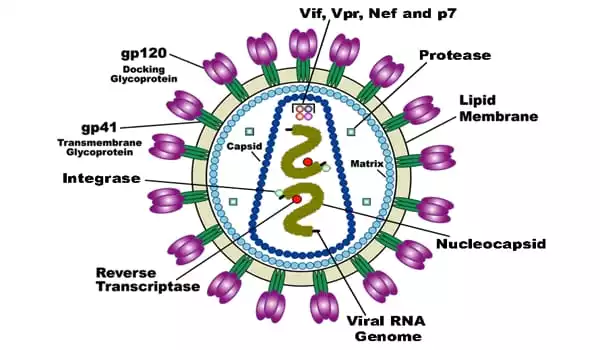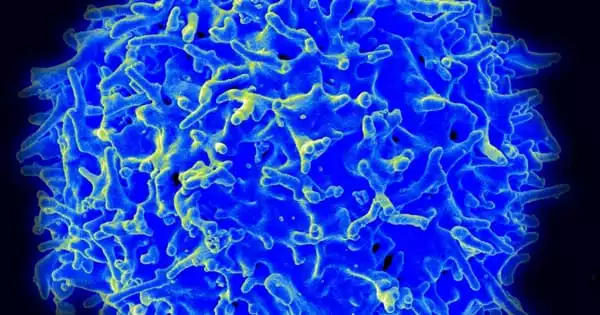HIV infects a type of white blood cell called a T-helper cell, which is part of the body’s immune system (also called a CD4 cell). These vital cells keep us healthy by defending us against infections and diseases. HIV is incapable of reproducing on its own. Instead, the virus attaches to and fuses with a T-helper cell (joins together). It then takes over the cell’s DNA, replicates itself within the cell, and finally releases more HIV into the bloodstream. The HIV lifecycle refers to the process by which HIV multiplies and spreads throughout the body.
HIV replication in the human body necessitates the packaging of specific viral RNAs into progeny virus particles. A new study has discovered how a small difference in the RNA sequence can allow viral RNA to be packaged for replication, potentially opening up new targets for future HIV treatments.
The study, which was published in the Proceedings of the National Academy of Sciences, discovered that HIV selects its viral RNA genome – the “source code” that it injects into healthy human cells to infect them – based on functions that can be attributed to just two nucleotides.
Viruses have their own genomic DNA or RNA — in the case of HIV, it’s RNA — and they have to package their genomic RNA, and that’s what this whole study is about. It’s a critical step in understanding how the virus replicates.
Karin Musier-Forsyth
“It’s just this two-nucleotide difference that has such a dramatic effect,” said Karin Musier-Forsyth, the study’s senior author, an Ohio Eminent Scholar, and a professor of chemistry and biochemistry at The Ohio State University. “We can prevent it from spreading inside the body if we can stop it from packaging its own genome.”
The authors of the study, who included National Cancer Institute researchers, hoped to answer a long-standing question in HIV biology research: how does the virus know to package its specific viral RNA to be copied in human cells?
“Viruses have their own genomic DNA or RNA — in the case of HIV, it’s RNA — and they have to package their genomic RNA, and that’s what this whole study is about,” she explained. “It’s a critical step in understanding how the virus replicates.”
RNA is a string of nucleotides that is found in all living things, including viruses, in some form or another. It carries the genetic information that allows the virus to replicate itself inside a host – the human body – in HIV. HIV RNA is made up of approximately 9,800 nucleotides.

HIV is a retrovirus, which means it has single-stranded RNA as its genetic material rather than the double-stranded DNA found in human cells. Retroviruses also have the reverse transcriptase enzyme, which allows them to copy RNA into DNA and then use that “copy” of DNA to infect human, or host, cells. When HIV infects a cell, it attaches to and fuses with the host cell first. The virus then uses the machinery of the host cell to convert the viral RNA into DNA and replicate itself. The newly replicated HIV then exits the host cell and infects other cells.
“As humans, we have many different types of RNA in our cells, including messenger RNA (mRNA), which is very abundant – and which everyone has heard about now, thanks to COVID-19,” Musier-Forsyth explained. “However, the viral genome from HIV is made in small amounts and is very selectively packaged as genomic RNA, in addition to serving as mRNA to make viral proteins. How does the virus identify this genomic RNA to package rather than just any old RNA in our cells?”
Researchers believed that if they could find an answer to that question, they would be able to develop drugs that would prevent the virus from replicating and infecting healthy human cells.
The researchers examined the structures of two nearly identical HIV RNA strings and discovered that the virus distinguished between genomic RNA and viral mRNA by using a two-nucleotide difference at the very end of the RNA strings. Because of the conformations, or structures, that it formed, one was found to be more efficient at being packaged as a genome than the other.
The findings may have implications for future HIV treatments that target RNA, as opposed to current HIV treatments, which primarily target viral proteins. Although new HIV drugs based on this discovery are unlikely to be available for several years, Musier-Forsyth believes it is an important scientific step.
“Now that we know more about the structure of RNA, we may be able to develop therapeutics, whether small molecules or other new nucleic acid therapeutics, that can lock the RNA into a non-packaging conformation. It cannot replicate if its genome cannot be packaged” According to Musier-Forsyth.
















